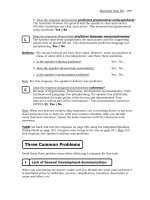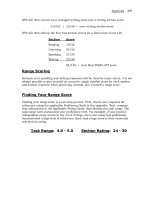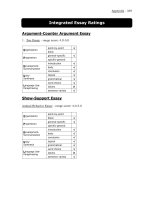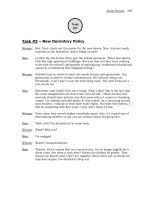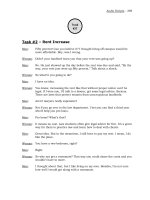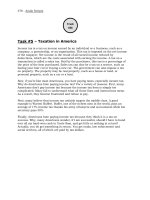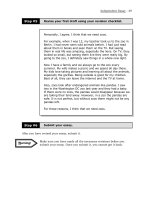Tài liệu Speaking and Writing Strategies for the TOEFL iBT part 18 ppt
Bạn đang xem bản rút gọn của tài liệu. Xem và tải ngay bản đầy đủ của tài liệu tại đây (375.75 KB, 10 trang )
Speaking Task One - 159
For this task, you will develop and verbally deliver a personal-opinion argument in
45 seconds. The task order follows.
For this task, you will answer a single-question prompt, for example:
Where have you seen single-question prompts before? The independent essay. In
fact, independent Speaking Task #1 is really just a mini independent essay.
However, instead of developing your argument in writing, you will develop it in 15
seconds, then deliver it verbally in 45 seconds.
How can you develop and deliver a mini verbal independent essay in 60 seconds?
By changing G+3TiC=C
to G+TiC=C.
Prompt Why do people travel? Develop your opinion using
examples and reasons.
Speaking Task One
Independent Task: Single-Question Prompt
Prompt Types
Task Time
3. Deliver your response.
45 seconds
1. Read the prompt.
2. Develop your response.
15 seconds
160 - Speaking Task One e
Because I’m a scientist, I use many
technologies. However, I can
honestly say that the technology that
has changed my life the most is the
internet. Using the internet makes
communication fast and easy, is good for
research and it saves me money.
First, the internet makes communication
fast and easy. For example, I’m from
China and I’m now working in the
United States. That means my family
and friends back in Beijing are very
far away. Yet by using the internet, I
can talk to them as much as I want.
The best way is Skype. Using Skype,
I can see their faces and they can see
mine. Before the internet, people like
my parents had to send letters. That
took so long. But the internet has
changed all that. The internet makes
communication fast and easy for me
and my family. It’s like magic. Best
of all, I don’t get homesick.
Next, the internet is good for research.
I’m a research physicist developing lasers
for weather testing. To research my
ideas, I always use the internet. It’s good
for finding articles and the latest research
papers that can help me with my
research. If I didn’t have the internet I’d
have to go to libraries. But with the
internet, all I have to do is search with
Google and I have the information right
at my fingertips.
Finally, the internet saves me money.
When I have questions about my work, I
can email scientists all over the world for
answers. This saves money because I
don’t have to travel. Also, scientists can
contact me and ask questions. For
example, last week a scientist from
Norway emailed me and asked about my
work. Before the internet, he would have
had to have flown or called long distance.
This is very expensive. But now we can
save time and money using the internet.
In sum, the internet has changed my
life the most. Using the internet is fast
and easy, is great for research and it
saves me money. Can you imagine a
world without the internet?
G Because I’m a scientist, I use
many technologies. However,
I can honestly say that the
technology that has changed
my life the most is the
internet.
TiC For example, I’m from China
and I’m now working in the
United States. That means
my family and friends back in
Beijing are very far away.
Yet by using the internet, I
can talk to them as much as
I want. The best way is
Skype. Using Skype, I can
see their faces and they can
see mine. Before the
internet, people like my
parents had to send letters.
That took so long. But the
internet has changed all that.
The internet makes
communication fast and easy
for me and my family. It’s
like magic. Best of all, I don’t
get homesick.
C In sum, the internet has
changed my life the most.
Independent Essay
Speaking Task One
TiC
TiC
TiC
C
G
Speaking Task One - 161
G+TiC=C will help you give the speaking raters what they are trained to listen for:
an independent spoken response that demonstrates OPDUL=C
.
Note the changes to OPDUL=C under Language Use. For this task, the raters will
also rate your *Delivery
.
When you speak, the speaking raters will measure the proficiency of your delivery
in these three areas: fluency, automaticity and pronunciation.
Fluency means how easily (naturally) you speak. Do you speak
smoothly and confidently, or do you hesitate and speak in
fragments?
Automaticity means how fast you think and speak. Do you
pause to translate, or do you think and speak automatically
without pausing to translate?
OPDUL=C
Organization
• deduction or induction
Progression
• general-specific or specific-general
Development
• introduction, body, conclusion
Unity
• topical and grammatical
Language Use
• word choice, idioms, sentence
variety
* Delivery: fluency
automaticity
pronunciation
O
P
D
U
L
Coherent
Independent
Spoken
Response
C
Fluency
Automaticity
Delivery
162 - Speaking Task One e
Pronunciation means how proficiently you produce the sound
of English words. Do you stress the right syllables with
accurate intonation and volume, or not?
Speaking subjectively means speaking about yourself. You are the subject, for
example:
“Hi, my name is Lilliana. I’m an architect from Buenos Aries, Argentina. Last
year, I graduated from university. Now, I’m working for an architect in
Barcelona, Spain. I have been so busy, but I love it. It’s like a dream come
true. Next year, I will return to Argentina and start my own business.”
Notice how Lilliana is speaking about herself using the first person singular
(I am…I graduated…I have been…I will return…). Because Lilliana is speaking
subjectively, she is confident about what she is saying. She is confident because
when she talks about herself, she makes fewer mistakes even when using idioms
(“It’s like a dream come true!”).
Fewer mistakes = greater language use proficiency = greater
coherence = a higher score.
For a basic spoken response, you must be able to organize your personal-opinion
argument quickly and proficiently while speaking subjectively. In this section, you
will learn these basic but essential speaking strategies. Later on in this chapter,
you will learn how to develop a basic response into an advanced response to
maximize scoring.
Before you begin independent Speaking Task #1, you will hear the directions for
the speaking section. The directions will last approximately two minutes. Do not
dismiss them. As you listen to the directions, make an G+TiC=C
note map.
Pronunciation
Speaking Subjectively
Remember!
Basic Response
Basic Response: Step-by-Step
1.
Speaking Task One - 163
When the speaking directions end, the prompt will appear on your screen. A
narrator will read it.
When the narrator stops speaking, a countdown clock will appear on your screen.
You will have 15 seconds to develop your response. The clock will count down (15,
14, 13 ). On your note map, jot down your opinion and one example
.
When the countdown clock reaches zero, you will hear a “Beep!” Look at your note
map. It is your guide. Start speaking. Speak subjectively. State your opinion, then
your supporting illustration. End with your conclusion. On the next page, notice
how the opinion is restated in the conclusion. By restating your opinion in your
conclusion, you will know exactly what to say and you will save time.
Prompt Why do people travel? Develop your opinion using
examples and reasons.
G = personally travel to learn
TiC = for example Manhattan
C = for those reasons
G = personally
TiC = for example
C = for those reasons
Make a G+TiC=C note map; include transitions.
Step #1
Read the prompt.
Step #2
Develop ideas (15 seconds).
Step #3
Speak (45 seconds).
Step #4
164 - Speaking Task One e
opinion
restated
opinion
When you are finished speaking, speaking task two will immediately
appear on your screen. Be ready for it.
Now check the sample practice response for Coherence using the proficiency
checklist. Remember to ask “yes-no” questions starting with O
rganization.
Does the response demonstrate organization?
The speaker uses deduction as a method of organization. This
demonstrates organization. Yes √ No _
Does the response demonstrate progression?
Because the speaker uses deduction, the ideas progress from general to
specific. This demonstrates progression. Yes √ No _
a. Does the introduction demonstrate development?
The speaker says, “Personally, I like traveling because it is a learning
experience.” This is an opinion. It is arguable, supportable, a complete
sentence and not a question. This demonstrates introduction development.
Yes √ No _
b. Does the body demonstrate development?
The speaker uses the supporting illustration of Manhattan and develops
it to describe the lesson learned from visiting Ground Zero. This
demonstrates body development. Yes √ No _
Personally, I like traveling because it is a learning experience.
For example, last year I went to Manhattan. I visited many
famous places like The Met and Radio City Music Hall. The most
interesting place was Ground Zero. Ground Zero is where the
World Trade Center once stood. Now, it's nothing but a big
hole. On TV it doesn’t look so big. But seeing it in person, I had
no idea it was so huge. It’s like a big hole in the heart of the
city. Looking at it made me realize that sometimes you just
have to see things with your own eyes. That way you can
understand what really happened.
For those reasons, traveling to Manhattan was definitely a
great learning experience for me.
Words: 126
Warning!!
O
P
D
Speaking Task One - 165
c. Does the conclusion demonstrate development?
The speaker restates her opinion in the conclusion. This demonstrates
conclusion development. Yes
√ No _
a. Does the response demonstrate topical unity?
The speaker focuses on the topic of Manhattan and the lesson she learned
there. There are no topic digressions. This demonstrates topical unity.
Yes √ No _
b. Does the response demonstrate grammatical unity?
The transitions (TiC) and (TO) are correct. This demonstrates grammatical unity.
Yes √ No _
a. Does the speaker demonstrate proficient language use?
The speaker uses an adverb clause of reason (“because it [traveling] is a
learning experience”) for the opinion and the superlative “most
interesting” to describe the example Ground Zero. In addition, the
speaker says “Ground Zero is like a big hole in the heart of the city.” This
figure of speech (idiom) is a simile using like to make a direct comparison.
There are no mistakes in syntax. Combined, this demonstrates proficient
language use. Yes √ No _
Note: We cannot evaluate the next three steps: delivery. However, when you
practice in class, or alone with a recording device, ask these three questions.
a. Is the speaker’s fluency proficient? Yes _ No _
b. Does the speaker demonstrate automaticity? Yes _ No _
c. Is the speaker’s pronunciation proficient? Yes _ No _
Note: For this response, the speaker’s delivery was proficient.
Does the response (argument) demonstrate coherence?
Because the speaker has proficiently demonstrated Organization,
Progression, Development, Unity and Language Use, the response is
coherent (OPDUL=C). The speaker’s argument is clear: “Traveling to
Manhattan was definitely a great learning experience.” Yes √ No _
U
L
C
166 - Speaking Task One e
Mapped out, you can see how G+TiC=C gives the speaking raters what they are
trained to listen for: a coherent spoken response that demonstrates OPDUL=C
.
Note: Transitions (T) are in bold, the supporting illustration (i) in italics, the
opinion (G) and the conclusions (C) underlined
.
G = general = Personally, I like traveling because it is a
learning experience.
TiC = specific = For example, last year I went to Manhattan.
I visited many famous places like The Met
and Radio City Music Hall. The most interesting
place was Ground Zero. Ground Zero is where the
World Trade Center once stood. Now it is nothing but
a big hole. On TV it doesn’t look so big. But seeing it
in person, I had no idea it was so huge. It’s like a
big hole in the heart of the city. Looking at it made
me realize that sometimes you just have to see
things with your own eyes. That way you can
understand what really happened.
C = general = For those reasons, traveling to Manhattan was
definitely a great learning experience for me.
Notice how the concluding sentences (TiC) state cause-and-effect relationships.
“Looking at it made me realize that sometimes you just have to see things
with your own eyes. That way you can understand what really happened.”
Cause-and-effect relationships are the reasons stated in the prompt.
If you are preparing for the TOEFL iBT alone, use a recording device to record your
voice. When you playback your response, rate your response using the
Independent
Speaking Proficiency Checklist, then score yourself using the Independent Speaking
Rating Guide. Identify those parts of OPDUL=C
you need to improve for greater
coherence, then record the same response with revisions. Playback the same
response. Check it again using OPDUL=C
, then rate it again.
Prompt Why do people travel? Develop your opinion
using examples and reasons.
Rating Yourself
Speaking Task One - 167
By repeating the same response, you will be able to automatically
remember G+TiC=C. This will give you more confidence. It will also
help you manage your speaking time more proficiently.
When preparing for the TOEFL iBT in a TOEFL class, ask your instructor and
classmates to check your response for coherence using the Independent Speaking
Proficiency Checklist in the appendix, then rate your response using the
Independent Speaking Rating Guide. Repeat the same response until you remember
G+TiC=C
automatically and can proficiently demonstrate OPDUL=C.
TASK: Rate the response about traveling and learning on page 166 using the
Independent Speaking Rating Guide on page 320. Compare your rating to the one
on page 340. Note
: For this response, the speaker’s delivery was proficient.
Do I have to use all 45 seconds? Is there some rule?
No. There is no official rule that says you have to speak for all 45 seconds.
A long response does not always mean a coherent response. On the
contrary, a long response often means a lack of coherence
(OPDUL=C
). Some test-takers simply speak and speak, thinking more
is better. Wrong. Your job is to deliver a response that proficiently
demonstrates OPDUL=C
. Do so using G+TiC=C.
Everyone speaks at a different pace. However, using G+TiC=C and speaking at a
natural pace, you will able to deliver a response that demonstrates OPDUL=C
in 45
seconds. The following map illustrates approximate time divisions for each step of
G+TiC=C
.
You are reading this example. On test day, you will pause and
hesitate when you speak and thus use more time.
G 5 seconds Personally, I like traveling because it is a
learning experience.
Rating in a Class
How Long Should My Response Be?
Remember!
Warning!!
Q
A
Remember!
168 - Speaking Task One e
TiC 35 seconds For example, last year I went to Manhattan. I
visited many famous places like The Met and Radio
City Music Hall. The most interesting place was
Ground Zero. Ground Zero is where the World
Trade Center once stood. Now it is nothing but a
big hole. On TV it doesn’t look so big. But seeing it
in person, I had no idea it was so huge. It’s like a
big hole in the heart of the city. Looking at it made
me realize that sometimes you just have to see
things with your own eyes. That way you can
understand what really happened.
C 5 seconds For those reasons, traveling to Manhattan was
definitely a great learning experience for me.
TASK: For practice timing yourself while you speak, read the sample responses
throughout this chapter.
Let’s map out another single-question response. Remember to use G+TiC=C and
the four steps to demonstrate OPDUL=C
in your response.
When the speaking directions end, the prompt will appear on your screen. A
narrator will read it.
Prompt Should teenagers work during high school? Why?
Give illustrations and reasons to develop your
argument.
G = personally
TiC = for example
C = for those reasons
Basic Response: Step-by-Step
2.
Make a G+TiC=C note map; include transitions.
Step #1
Read the prompt.
Step #2
